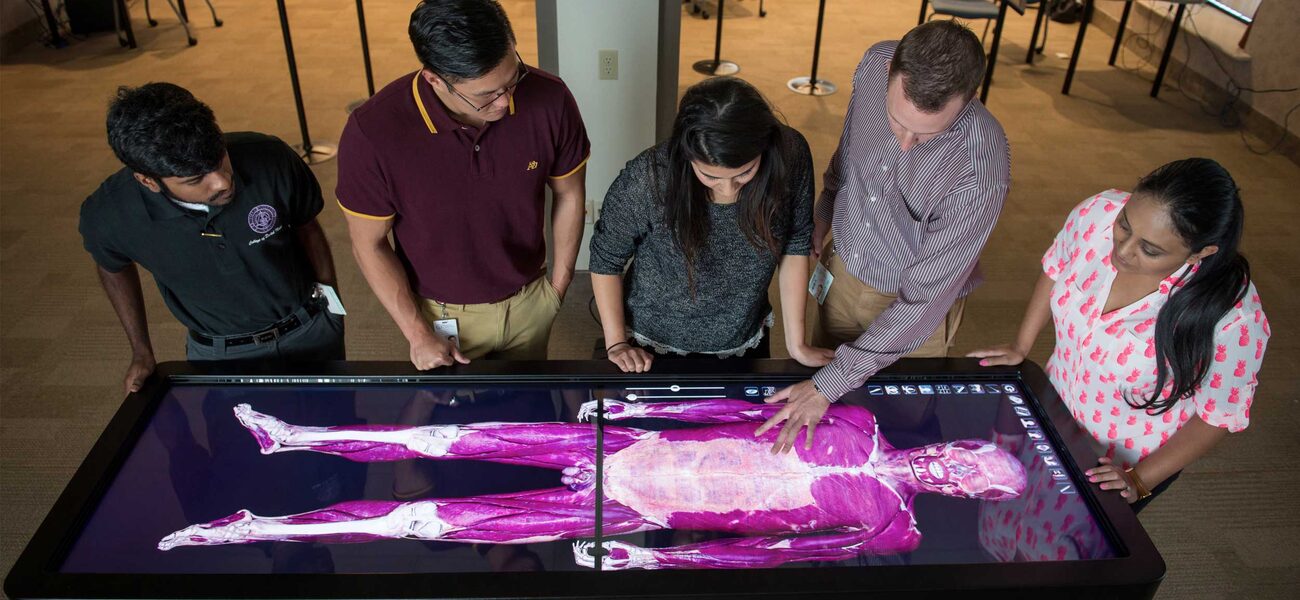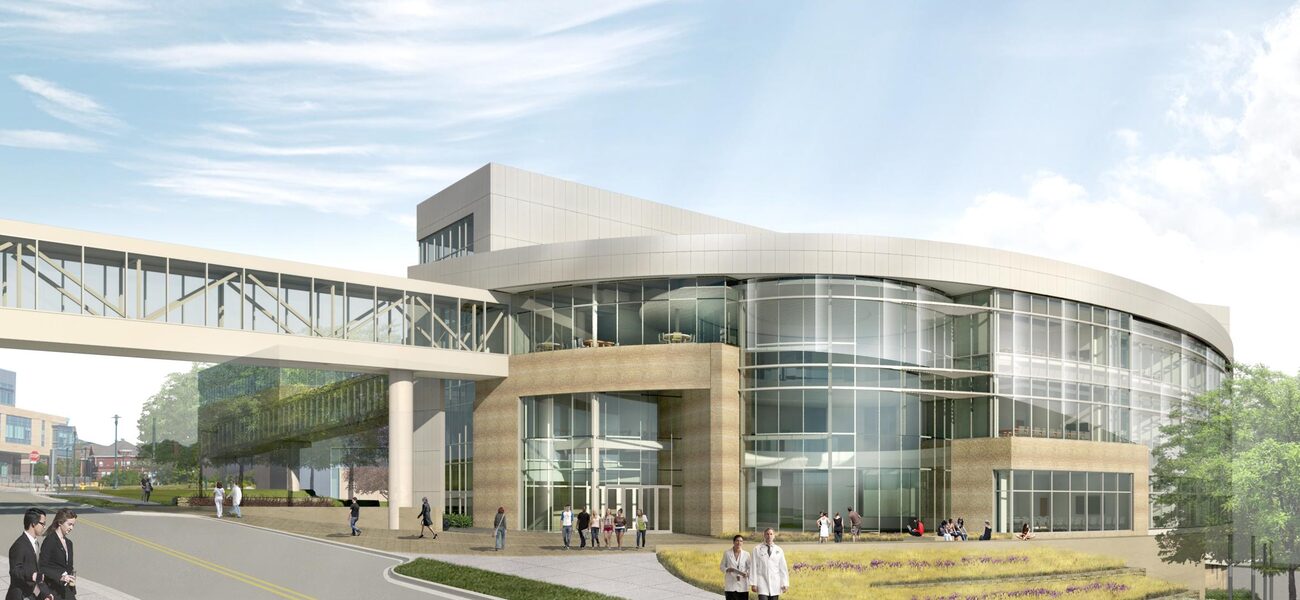Virtual and augmented reality are bringing new learning experiences to today’s medical students—and their campuses. The building boom is part of a revolution in the way medicine is taught. Today, medical students often learn with sophisticated mannequins, computer models, and collaborative electronic projects. Now, some schools are taking the technology a step further, building immersive environments where the doctors, nurses, and dentists of tomorrow can experience real medical settings and explore human anatomy in three dimensions.
In Ohio, Case Western University is partnering with the Cleveland Clinic to build a shared space for medical, nursing, and dental students to collaborate using several forms of simulation. The Health Education Campus, currently under construction, will be 550,000 sf of learning space centered around a large atrium aimed at sending a visual message about the importance of collaboration.
“I think we’ll have upwards of 2,500 students a day in this platform,” says William Peacock, COO of the Cleveland Clinic, which demolished an out-of-date hotel to create the 11-acre site.
Planning for the $515 million project began in 2013, and the first students are expected to use the building in the fall of 2019. Because of the role of technology in the building, technology integrator Westlake Reed Leskofsky (now owned by DLR) worked closely with the architect, Lord Norman Foster of London’s Foster + Partners.
One of the challenges was getting the individual schools to participate collaboratively in the planning process, just as they hope their students will participate collaboratively in learning experiences in the new facility.
“As you can imagine any academic institution, they think along the lines of their own schools, so bringing them together to think about the shared space was really important,” says Peacock.
[Pamela B. Davis, MD, PhD, dean and senior vice president for medical affairs at Case Western Reserve University School of Medicine, will be speaking about “Medical education reinvented: Big data, 3D visualization, and augmented reality reshapes facility planning metrics,” at the Facility Strategies for Medical Schools and the Health Sciences conference, October 5-6 in Boston.]
3D Anatomy Holograms
Among the most attention-getting plans for the new site is the use of Microsoft’s HoloLens, a wearable computer that allows individuals or small teams to interact with dynamic anatomical models in three-dimensional space. Students can see and walk around the model, interacting to explore specific functions or observe an organ’s operation in real time from different angles.
As described by a Microsoft spokesperson, “Microsoft HoloLens is the world’s first self-contained holographic computer. HoloLens runs Windows 10 and is completely untethered, meaning, no wires, phones, or connection to a PC are needed. HoloLens allows you to pin holograms in your physical environment.”
To provide a suitable environment for the technology, says Peacock, the designers needed to allow for amplified Wi-Fi bandwidth in the facility, as well as set up an environment where light can be controlled so the holographic images have the most impact.
The Cleveland building is also being designed to meet LEED Silver criteria for environmentally sensitive building methods. Once complete, it is meant to be as paperless as possible, immersing students in the world of electronic health records—yet another reason to go strong on the Wi-Fi bandwidth.
Meanwhile, 800 Miles West…
The University of Nebraska Medical Center is also bringing together students from different medical fields in its new Davis Global Center for Advanced Interprofessional Learning.
The 191,884-sf project, part of a wider initiative to immerse students in lifelike medical settings, puts together $102 million from private and public sources for a building that incorporates virtual reality, a media development studio, and technology for creating and sharing content to remote locations.
“We are adopting augmented reality wherever it makes sense to provide the best training experience possible,” says Dr. Pamela Boyers, associate vice chancellor for clinical simulation and the key person implementing this technology across the Nebraska campuses.
Based on her experience with a similar facility at the University of Toledo, Boyers saw the need to bring the technology partners into the planning and design process early. “We feel the technology integrator is every bit as important as the architect,” she says.
When the architects, RDG Planning and Design and Clark Enersen Partners, were brought on board, so was AVI-SPL, the technology integrator. Construction is under way, and the first students are expected in September 2018, when the university will host the National Modeling & Simulation Coalition Annual Meeting.
“The architect and technology people have to work very closely together,” explains UNMC Chancellor Jeffrey P. Gold. “It’s like no space that you’ve been in. It’s designed around the technology. There’s a lot of glass, ways of controlling lighting and foot traffic, breakout and communication space.”
Millions of Pixels
The Nebraska project also employs HoloLens, and already has some of its technology in temporary quarters while the new building is in progress. Bill Schmidt, sales director for AVI-SPL, described some of the elements being installed:
- iEXCEL Helix, a 280-degree, curved-screen work environment that can display 2D and 3D images individually or simultaneously, allowing work groups to collaborate on a large 132-million-pixel canvas
- The Laser Cave, similar to the Cleveland environment, allowing small groups to explore anatomical structures in an immersive environment. Schmidt says they went with Barco as the vendor for this section because their mechanical structure and screen materials were the most advanced, allowing UNMC to build a first-of-its kind room.
- A holographic theater displaying prepared or live content in three dimensions, using a 16-by-9-foot LED display table. The technology is currently used mostly in entertainment settings; here, it will be a permanent installation for educational purposes. As an example, Schmidt offers the possibility of capturing a lecture by a distinguished scholar and playing it back years later, the audience unable to tell that the presenter wasn’t live.
- iEXCEL Wall, a 20-foot-wide curved surface, all of it touch-enabled. Meant to engage and teach people who have grown up with touchscreens, the MultiTaction product also allows collaboration with remote campuses. A demonstration in May brought together groups of students in Omaha and Scotts Bluff, 450 miles away, to collaborate on anatomical content. As Schmidt says, “Millennials just walk up to the thing and they know how to use it already.”
- Simulation floors offer realistic settings ranging from a patient’s home to an intensive care unit. HD video cameras, ceiling microphones, and intercoms capture training sessions for live viewing and later playback, and allow instructors to provide feedback during simulations.
In April, Gold used HoloLens to appear as a holographic version of himself before the Board of Regents, which was meeting 200 miles away.
Technology That Expresses Ideas
Schmidt says that after being awarded the contract, AVI-SPL interviewed members of the university community—not just administrators, but people on the front lines of helping students learn—to determine that community’s aspirations. With that information they created a set of common goals that informed their criteria for whether their projects would succeed.
Working in tandem with the architects, rather than fitting technology into already-designed spaces, was a luxury for the integrators. “As spaces started to get defined, technology packages started to go along with those rooms. It wasn’t like we had a technology to squeeze into an envelope. We had a building that was fulfilling the technology goals,” says Schmidt. For instance, the immersive “cave” requires a two-story space, with the lower floor housing the light engines that create the environment for users in the floor above.
Thinking through technology spaces also includes nitty-gritty details like deciding where the server racks will go and making sure they are accessible in case of a failure, and ensuring that as many elements as possible involve commercially available products so that the institution can maintain them.
For AVI-SPL, the project has led to opportunity. The firm is opening an office in Omaha and providing high-tech “tumor board” rooms for the Buffett Cancer Care Center, allowing teams to confer while referring to medical imagery on high-resolution 85-inch monitors, all protected behind firewalls and other security measures for HIPAA compliance.
Not every university can afford a brand-new building, but many are finding ways to participate in the simulation boom nonetheless. Dr. Robert Hasel, associate dean of Western University of Health Sciences College of Dental Medicine in Pomona, Calif., is bullish on the current environment for simulation in training for health careers. “There’s a convergence of hardware and software that was never available before. We have the computing power to manipulate and deliver high-resolution files,” he says.
Among his projects is a computer engine that follows each student’s learning pathway and performs big-data analysis of the individual’s level of mastery. Western chose a former library space to renovate as a simulation center for the university’s nine different health science programs. “All of those students are required to take anatomy,” explains Hasel, and Western is even offering its anatomy simulation content to students from other schools.
Hasel wanted the Virtual Reality Learning Center to be flexible as technology improves, so furniture travels on wheels. Its technology offerings currently include the Anatomage Virtual Dissection table, a simulated operating table with high-resolution images of more than 300 “patients” available.
He’s not done. “We want to embrace future developments. I’m looking forward to artificial reality,” says Hasel.
By Patricia Washburn




